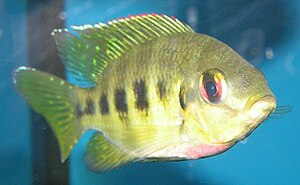Pelmatolapia
| Pelmatolapia | ||||||||||||
|---|---|---|---|---|---|---|---|---|---|---|---|---|

|
||||||||||||
| Systematics | ||||||||||||
|
||||||||||||
| Scientific name of the tribe | ||||||||||||
| Pelmatolapiini | ||||||||||||
| Dunz & Schliewen , 2013 | ||||||||||||
| Scientific name of the genus | ||||||||||||
| Pelmatolapia | ||||||||||||
| Thys van den Audenaerde , 1969 |
Pelmatolapia is a genus of cichlids consisting of two species, which occurs in West Africa in coastal rivers of the Ivory Coast and from Benin and Cameroon via the mouth of the Congo to the mouth of the Cuanza . The genus originally had the rank of a sub-genus within the paraphyletic genus Tilapia and was raised to the genus rank in 2013 by Dunz and Schliewen.
features
The two species of the genus have a typical, moderately high-backed cichlid shape and reach lengths of 32 and 37 cm. Both of them show a vertical pattern of 5 or 6 stripes, especially when young, which can be reduced to spots in adult animals. The stripes or spots are closer together in the back of the body. The body is covered with round scales. 25 to 27 are in a central longitudinal row. Like almost all cichlids, Pelmatolapia has two sidelines . Further characteristics typical of the genus are the lower pharyngeal jaw consisting of the fused fifth ceratobranchials , which is as wide as it is long and has a front keel that is shorter or almost as long as the dentate area. The rear pharyngeal teeth are two-pointed, less often three-pointed. The first gill arch carries 12 to 19 gill rakes. In both jaws, the teeth of the outer row of teeth are two-pointed, the inner row is covered with small three-pointed teeth. The teeth are narrow and spade-shaped. The dorsal fin is supported by 15 to 16 hard rays and 7 to 8 unbranched soft rays. It shows a typical tilapia stain . The pelvic fins are pointed. Pelmatolapia are substrate spawners .
species
- Pelmatolapia cabrae (Boulenger, 1899)
- Pelmatolapia mariae (Boulenger, 1899) ( type species )
Systematics
The systematic classification of the genus and the monotypical tribe Pelmatolapiini is difficult and so far unexplained, as P. mariae shows more similarities with the Boreotilapiines (the northern clade of the Haplotilapiine cichlids, mainly found in West Africa) in the phylogenetic analysis and also in the distribution area of this group lives, but P. cabrae is closer to the Austrotilapiines (the southern clade of the Haplotilapiine cichlids, mainly found in Central, East and South Africa) and lives in the range of this clade.
literature
- J. Daget, J.-P. Grosse, GG Teugels, DFE Thys van den Audenaerde: Check-list of the freshwater fishes of Africa (= Catalog des poissons d'eau douce d'Afrique. ) ISNB / MRAC / ORSTOM, Bruxelles / Tervuren / Paris 1991, Volume 4, OCLC 875500418 , pp. 1-740.
- DFE Thys van den Audenaerde: An annotated bibliography of Tilapia (Pisces, Cichlidae). Documentation Zoologique / Musée de l'Afrique centrale. No. 14. 1969, pp. 1-406.
- Andreas R. Dunz: Revision of the substrate brooding “Tilapia” (Tilapia Smith, 1840 and related taxa), (Teleostei: Perciformes: Cichlidae). (= Dissertation, Faculty of Biology, Ludwig Maximilians University Munich.) Munich 2012, ( PDF ).
- Andreas R. Dunz, Ulrich K. Schliewen: Molecular phylogeny and revised classification of the haplotilapiine cichlid fishes formerly referred to as “Tilapia”. Molecular Phylogenetics and Evolution, doi: 10.1016 / j.ympev.2013.03.015 .
Web links
- Pelmatolapia on Fishbase.org (English)